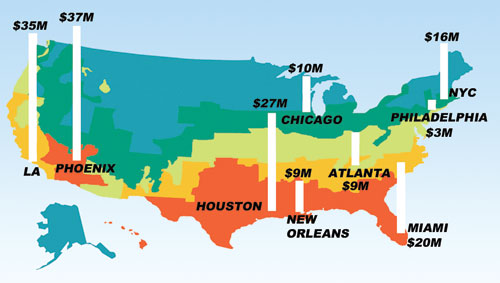Cool Roofs for Hot Projects
Cooling Off the Planet
A LBNL study found that world-wide reflective roofing has the potential to produce a global cooling effect equivalent to offsetting 24 gigatons of CO2 over a 20 year use of the roofs. This is comparable to taking 300 million cars off the road over the same time period and equates to $600 billion in energy savings.4 The study recommends cool roofs as a geo-engineering mechanism to counteract climate change. The method by which cool roofing operates as a global cooling strategy is simple. Reflected sunlight effectively passes through the atmosphere, whereas sunlight that has been absorbed and then re-radiated from earth surfaces does not pass through easily, but is held within the atmosphere.
Quantifying Energy Savings
Research by the LBNL Heat Island Group found that buildings with lightly colored, more reflective roofs use up to 40 percent less energy for cooling than buildings with darker roofs.5 To calculate the possible savings in energy provided by a cool roof, there are two online roof calculators that estimate savings.
 |
Nationwide implementation of cool roofs could mean an annual savings of $1 billion in cooling costs, according to a study by Lawrence Berkeley Laboratory's Heat Island Group. Values shown reflect 1997 energy prices. Image courtesy of LBNL Heat Island Group |
Â
- The Department of Energy (DOE)Â Cool Roof Calculator was developed by the U.S. DOE's Oak Ridge National Laboratory (ORNL). This calculator provides an estimate of cooling and heating savings for small to medium sized flat-roof facilities.
- The Roof Savings Calculator was developed by LBNL and ORNL. This calculator is designed for both residential and commercial buildings using whole-building energy simulations. It allows the designer to input specific det ails about a building, including heating and cooling systems as well as location and the cost of energy.
These calculators provide a simple payback analysis to determine the possible savings in electricity or natural gas through the installation of a cool roof. As each project's savings will be unique, these calculations can provide a nuanced analysis of savings benefits.
Specifying the Perfect Roof: Product Rating Resources, Product Types, Building Programs and Codes
A cool roof should be chosen based on the slope of the roof, energy savings goals, the project location and climate, local code requirement or green building credits, as well as aesthetic preferences. Designers who are seeking sustainable design credits may also want to consider the cradle-to-cradle aspects of their materials choices, including recycled content, end of life recyclability and avoidance of toxic materials. Other sustainability considerations include the source location and weight of the product, which affect raw material use and shipping fuel, as well as the environmental impact of raw material extraction and manufacture processes.
Once the project parameters have been established, an appropriate roofing product must be selected. Several building codes, as well as voluntary green building programs, either require or allow you to achieve credits for including cool roofs in a project. Fortunately there are product rating resources available to help you specify the perfect cool roof for your project.









